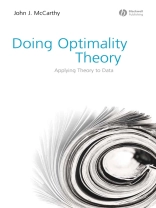Doing Optimality Theory brings together examples and practical, detailed advice for undergraduates and graduate students working in linguistics.
Given that the basic premises of Optimality Theory are markedly different from other linguistic theories, this book presents the analytic techniques and new ways of thinking and theorizing that are required.
* Explains how to do analysis and research using Optimality Theory (OT) – a branch of phonology that has revolutionized the field since its conception in 1993
* Offers practical, in-depth advice for students and researchers in the field, presented in an engaging way
* Features numerous examples, questions, and exercises throughout, all helping to illustrate the theory and summarize the core concepts of OT
* Written by John J. Mc Carthy, one of the theory’s leading proponents and an instrumental figure in the dissemination and use of OT today
* An ideal guide through the intricacies of linguistic analysis and research for beginning researchers, and, by example, one which will lead the way to future developments in the field.
Given that the basic premises of Optimality Theory are markedly different from other linguistic theories, this book presents the analytic techniques and new ways of thinking and theorizing that are required.
* Explains how to do analysis and research using Optimality Theory (OT) – a branch of phonology that has revolutionized the field since its conception in 1993
* Offers practical, in-depth advice for students and researchers in the field, presented in an engaging way
* Features numerous examples, questions, and exercises throughout, all helping to illustrate the theory and summarize the core concepts of OT
* Written by John J. Mc Carthy, one of the theory’s leading proponents and an instrumental figure in the dissemination and use of OT today
* An ideal guide through the intricacies of linguistic analysis and research for beginning researchers, and, by example, one which will lead the way to future developments in the field.
Table of Content
Acknowledgments.Read This First!.
List of Abbreviations.
1. An Introduction to Optimality Theory.
1.1 How OT Began.
1.2 Why Must Constraints Be Violable?.
1.3 The Nature of Constraints in OT.
1.4 Candidate Sets: OT’s Gen Component.
1.5 Candidate Evaluation: OT’s Eval Component.
1.6 Constraint Activity.
1.7 Differences Between Languages.
1.8 The Version of OT Discussed in This Book.
1.9 Suggestions for Further Reading.
2. How to Construct an Analysis.
2.1 Where to Begin.
2.2 How to Rank Constraints.
2.3 Working through an Analysis in Phonology.
2.4 The Limits of Ranking Arguments.
2.5 Candidates in Ranking Arguments.
2.6 Harmonic Bounding.
2.7 Constraints in Ranking Arguments.
2.8 Inputs in Ranking Arguments.
2.9 Working through an Analysis in Syntax.
2.10 Finding and Fixing Problems in an Analysis.
2.11 Constraint Ranking by Algorithm and Computer.
2.12 The Logic of Constraint Ranking and Its Uses.
3. How to Write Up an Analysis.
3.1 Introduction.
3.2 How to Organize a Paper.
3.3 How to Present an OT analysis.
3.4 The Responsibilities of Good Scholarship.
3.5 How to Write Clearly.
3.6 General Advice about Research Topics.
4. Developing New Constraints.
4.1 Introduction.
4.2 When Is It Necessary to Modify Con?.
4.3 How to Discover a New Constraint.
4.4 How to Define a New Constraint.
4.5 Properties of Markedness Constraints.
4.6 Properties of Faithfulness Constraints.
4.7 Justifying Constraints.
4.8 A Classified List of Common Phonological Markedness
Constraints.
5. Language Typology and Universals.
5.1 Factorial Typology.
5.2 Languages Universals and How to Explain Them in OT.
5.3 Investigating the Factorial Typology of a Constraint
Set.
5.4 Using Factorial Typology to Test New Constraints.
5.5 Factorial Typology When Con Isn’t Fully Known.
5.6 How to Proceed from Typology to Constraints.
6. Some Current Research Questions.
6.1 Introduction.
6.2 How Does a Language Vary?.
6.3 How Is Language Acquired?.
6.4 Does OT Need Derivations?.
6.5 How Is Ungrammaticality Accounted For?.
6.6 Is Faithfulness Enough?.
Afterword.
References.
Constraint Index.
Language Index.
Subject Index
About the author
John J. Mc Carthy is Distinguished Professor of Linguistics at the University of Massachusetts, Amherst. His widely cited but unpublished manuscript ‘Prosodic Morphology I: Constraint Interaction and Satisfaction’ (with Alan Prince, 1993) has been an important factor in the dissemination of Optimality Theory. He is also the author of Formal Problems in Semitic Phonology and Morphology (1985), A Thematic Guide to Optimality Theory (2002), and Hidden Generalizations: Phonological Opacity in Optimality Theory (2007), as well as the editor of Optimality Theory in Phonology: A Reader (Blackwell, 2004).
Language English ● Format PDF ● Pages 328 ● ISBN 9781444301199 ● File size 2.3 MB ● Publisher John Wiley & Sons ● Published 2009 ● Edition 1 ● Downloadable 24 months ● Currency EUR ● ID 2388065 ● Copy protection Adobe DRM
Requires a DRM capable ebook reader












